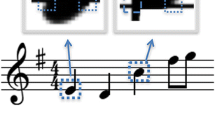Abstract
This paper presents a complete framework for recognizing classes of machine-printed musical manuscripts. Our framework is designed around the decomposition of a manuscript into objects such as staves and bars which are processed with a knowledge base module that encodes rules in Prolog. Object decomposition focuses the recognition problem, and the rule base provides a powerful and flexible way to encode the rules of a particular manuscript class. Our rule-base registers notes and stems, eliminates false-positives and correctly labels notes according to their position on the staff. We present results that show 99% accuracy at detecting note-heads and 95% accuracy in finding stems.
An expanded version of this paper is available via the World Wide Web at http://www.dcs.uky.edu/ ∼ seales
Preview
Unable to display preview. Download preview PDF.
Similar content being viewed by others
References
Dorothea Blostein and Henry S. Baird. A critical survey of music image analysis. In H. S. Baird, H. Bunke, and K. Yamamoto, editors, Structured Document Image Analysis. Springer, 1992.
Nicholas P. Carter and Richard A. Bacon. Automatic recognition of printed music. Dept. of Physics, University of Surrey, GB., 1992.
Ichiro Fujinaga. Optical music recognition using projections. Master's thesis, Mc-Gill University, Montreal, CA, 1988.
Ichiro Fujinaga, B. Alphonce, B. Pennycook, and G. Diener. Interactive optical music recognition. In Proceedings of the International Computer Music Conference, pages 117–120, San Jose, 1992.
Ichiro Fujinaga, Bo Alphonce, and Bruce Pennycook. Issues in the design of an optical music recognition system. In Proceedings of the International Computer Music Conference, pages 113–116, Ohio State University, November 1989.
T. Gaasterland, J. Minker, and A. Rajasekar. Deductive Database Systems and Knowledge Base System. In Proceedings of VIA 90, Barcelona, Spain, 1990.
G.Cook. Teaching Percussion. Schirmer Books, Collier Macmillan Publishers, New York, 1988.
Gonzales and Woods. Digital Image Processing. Addison-Wesley, 1993.
Bharath R. Modayur, Visvanathan Ramesh, Robert M. Haralick, and Linda G. Shapiro. Muser — a prototype musical score recognition system using mathematical morphology. Intelligent Systems Laboratory, EE Dept, FT-10, University of Washington, Seattle WA 98195, June 1992.
T. Moko-Oka. Challenge For Knowledge Information Processing Systems (Preliminary Report on Fifth Generation Computer Systems). In Proc. International Conference on Fifth Generation Computer Systems, pages 1–85, 1981.
Martin Roth. OMR — optical music recognition. diploma thesis, Swiss Federal Institute of Technology, Institute for theoretical computer science, ETH Zürich, CH-8092 Zürich, Switzerland, October 1992.
Author information
Authors and Affiliations
Editor information
Rights and permissions
Copyright information
© 1995 Springer-Verlag Berlin Heidelberg
About this paper
Cite this paper
Seales, W.B., Rajasekar, A. (1995). Interpreting music manuscripts: A logic-based, object-oriented approach. In: Chin, R.T., Ip, H.H.S., Naiman, A.C., Pong, TC. (eds) Image Analysis Applications and Computer Graphics. ICSC 1995. Lecture Notes in Computer Science, vol 1024. Springer, Berlin, Heidelberg. https://doi.org/10.1007/3-540-60697-1_101
Download citation
DOI: https://doi.org/10.1007/3-540-60697-1_101
Published:
Publisher Name: Springer, Berlin, Heidelberg
Print ISBN: 978-3-540-60697-0
Online ISBN: 978-3-540-49298-6
eBook Packages: Springer Book Archive




